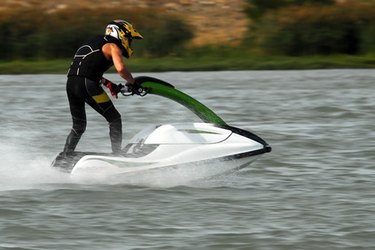Things You'll Need
Garden hose
Water supply

Flushing a Kawasaki jet ski after it has been ridden on the water helps to ensure that all of the engine's inner parts work as efficiently as possible. Flushing water and debris from a jet ski after each use is important, especially when riding it in saltwater. Properly flushing a jet ski does not take a lot of time, and it helps prepare the watercraft for the next outing on the lake or ocean.
Step 1
Pull the Kawasaki jet ski on the trailer and properly secure it. If possible, leave the jet ski on the boat launch ramp so that the rear is lower than the front.
Step 2
Open the drain plugs at the rear of the Kawasaki jet ski and start the engine. Run the engine for 10 to 15 seconds and turn the accelerator once or twice to flush the water from the engine.
Step 3
Connect a garden hose to the flush port of the Kawasaki jet ski. The flush port is normally located at the front of the watercraft under the hood.
Step 4
Start the jet ski and then turn on the water to a low setting. Run the jet ski's engine for a couple of minutes while the hose is connected to the flush port. Turn the accelerator a few times during this process to help flush the engine.
Step 5
Turn the water off and crank the accelerator once or twice to flush out any remaining water. Disconnect the hose from the flush port and reattach the cap.
Tip
Dry the jet ski with a towel after flushing the engine. This will help remove any excess water from the engine.
Some Kawasaki jet ski models may require a flush kit with hoses and connections for flushing the engine. These can be purchased online or at local marine supply retailers.
Warning
Flushing a jet ski is more important if it is ridden in saltwater. Over time, salt deposits can cause damage to a jet ski engine.